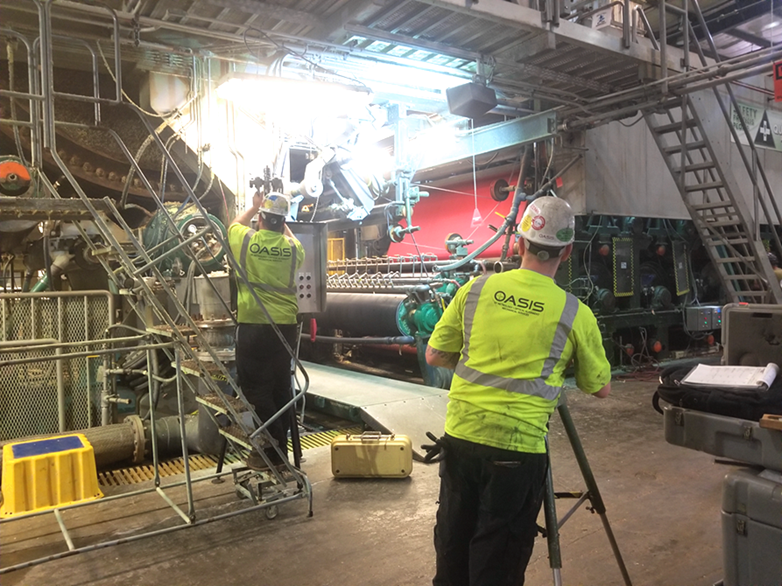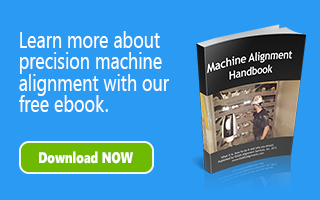It’s no secret that the COVID-19 pandemic created a huge demand for household tissue and towel products. This resulted in tissue manufacturers having to quickly alter their operational plans to meet market demand. Many tissue mills not only began adding more shifts in an effort to increase production, many also converted machines, delayed scheduled maintenance downs, and pushed their machines to work harder than ever before.
In a study published by Fisher International in December of 2020, titled COVID-19 Poised to Structurally Alter Tissue and Towel Sector, it was noted among other findings, that with the tissue supply chain stabilizing, tissue manufacturers can now address maintenance concerns that have been neglected due to delaying downs while running at full capacity for months.
In part one of this article, we discuss how tissue manufacturers can benefit from including machine alignment in their upcoming maintenance downs. In part two, we will provide an overview of the areas of the machine that are most impacted by alignment related issues and provide tips to help get your tissue machine back to running at optimal performance level.
Why Tissue Machine Alignment NOW?
Tissue machines are typically designed to run at much faster speeds than other paper machines. However, the faster the machine speed, the tighter the tolerances are for alignment of components. Given that most tissue manufacturers have been running their machines at max capacity for much of these past 12 months and taking less downtime for maintenance, the time is now to take a look at the impact this has had on equipment performance.
Many of you are familiar with a maintenance program known as “Run to Failure” and unfortunately, the pandemic has pushed some manufacturers to revert to this type of program due to having to keep up with demand. This can truly cause a domino effect. Machinery has limits – and costly product issues and component failures ultimately will emerge:
- Bearing and coupling failures
- Journal failures
- Excessive roll cover wear
- Wire and felt wear
- Poor product tracking
- Web breaks
- Wrinkles
- Increased scrap rates
- Leaks – oil, hydraulics, air
- Reduced operating speeds
Where to start?
Plan to include alignment inspections and/or alignment adjustments in both your short outages and your longer outages. During a short outage, an alignment audit can be performed to generate a baseline of the current machine alignment condition. This inspection data helps to identify and document problem areas that will allow you to make your longer downs much more efficient.
During short downs:
- Perform machine centerline survey and baseline installation (if not present) *
- Implement machine alignment audit
- Document current machine alignment condition
- Generate plan for addressing alignment related issues in longer downs
- Align newly installed rolls or replaced components relative to others in the section
*Baseline installation is only performed after determining the machine’s overall centerline and can often be accomplished in one shift. Aligning components to a common reference over the entire length of the machine ensures a proper product transition from one section of the machine to another and eliminates the accumulation of errors that can occur from roll-to-roll alignment. Additionally, the availability of a baseline reference reduces the time required to align new and relocated equipment as the need to inspect a number of adjacent components for the purpose of selecting a common datum is eliminated. For more on the importance of establishing a baseline, check out How to Align Machines: Getting Back to Basics.
During longer downs:
- Perform mechanical alignment adjustments by section
- Address all hardware replacements and alignment of associated components:
- Bearings
- Pivot pins and/or bushings
- Alignment of pivot arms
- Alignment of rolls mounted to pivot arms
- Drive assemblies – any driven component that is inspected should also have the drive assembly inspected
- Alignment of the roll will often also require re-alignment of the drive assembly
- Reel primary arm assemblies
- Gears on the cross shaft and the primary arm become worn over time
- Precision alignment of arms such that they are timed and proper reel ‘turn-ups’ occur, results in smooth and continuous operation
- When hardware replacements require the removal of the reel drum from pedestals and the disassembling primary arms, alignment is necessary when the components are put back in position
- Reel drum, primary arm cross shaft, and timing of primary arms
- Gears on the cross shaft and the primary arm become worn over time
Be sure check back for part two of our series on the importance of tissue machine alignment. In part two we will review the areas of the machine that are most impacted by alignment related issues and provide tips to help get your tissue machine back to running at optimal performance levels.
In the meantime, please don’t hesitate to contact us – an OASIS representative would be happy to discuss your specific equipment needs either in person (if your mill allows), over the phone, or via a virtual online meeting.

